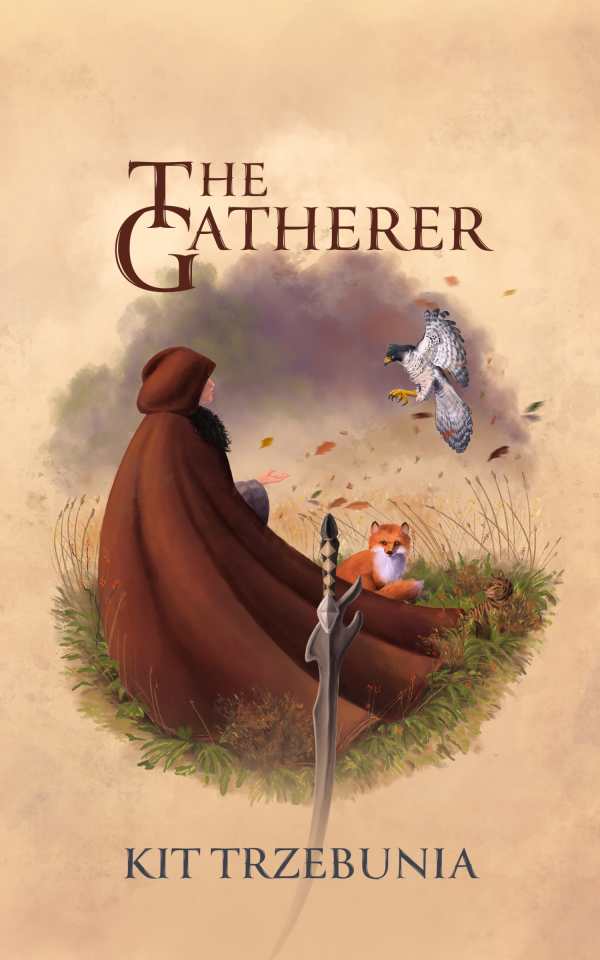The Gatherer
The Gatherer is a romantic epic set in magical lands that stars a gifted, irresistible girl.
In Kit Trzebunia’s fantasy novel The Gatherer, a talented girl struggles to adjust to her new family situation amid outside political tensions.
Peregrine, the daughter of an esteemed ranger, studies healing and weaponry while struggling to live with her new stepmother, whom she dislikes and distrusts. In time, Peregrine discovers that she has a unique connection to animals. After her father goes missing and is presumed dead, Peregrine meets a prince who’s harboring a secret and has a target on his back; their futures intertwine.
Though its framework is familiar, the novel is distinguished by its fresh characterizations, as with Peregrine’s communications with animals and her special connection to cats. The animals’ communications are a source of entertainment, too, as when a falcon chides Peregrine for longing for the former’s freedom: “You strain as a restless horse strains to get away from a cart he must draw.” And Peregrine’s father is a wise and compassionate soul whose eventual absence is felt, though his taste in selecting a wife who is later shown to be a manipulator is surprising.
Peregrine’s stepsister is loving and trope-defying; she proves her mettle by sticking up for Peregrine to her mother. “Take all of Lady Carola’s charm,” Peregrine says of her, “exchange ingenuity with ingenuousness, throw in a heaping dash of whimsy, and you have Wennie, in a buttercup.” And the prince is a natural choice for Peregrine: he’s loved by animals as much as she is, and he is a sympathetic companion despite their different stations in life. Their romance blooms in a gradual manner, moved along by flowing prose. Excellent physical descriptions flesh out the characters further, giving color to their attitudes, manner of dress, and cultural upbringings, all while heightening the world’s fantastic atmosphere—which includes tensions with Din Sul, where the emperor works with mages who command powerful magic.
Most often, Peregrine narrates the story, her point of view maturing with each new challenge. The book includes some shifts to encompass the Din Sul emperor’s situation, though, capturing him from an omniscient perspective. Peregrine’s spirited voice and early countryside exist in stark contrast to events in the emperor’s vicinity—as though the scenes belong to different books altogether. In time, these storylines intersect.
Oddities in the book’s turns of phrase give added shape to the realm. Peregrine celebrates her “age day” and receives the gift of a lovely box; Peregrine addresses her love interest in formal terms, as “my lord prince.” And exquisite details are used to vivify each setting, as with a chamber that features a basin
tiled in various soft shades of blues and greens, turning the contents a color that brought to mind my father’s descriptions of the sea. Spanning the pool, water cascaded like a constant, gentle rain from an arch that seemed formed of glistening, multicolored pebbles. The droplets caught the light from the windows and gleamed like falling moonstones.
Elsewhere, the emperor’s orchards are protected from the elements by magic, and an enchanted figurine that Peregrine’s father brings back for her dances when music is nearby, its beauty making her want to meet a girl from Din Sul in real life.
A romantic epic set in magical lands, The Gatherer stars a gifted girl who copes with her father’s absence by honing her healing powers and connections to animals.
Reviewed by
Stephanie Marrie
Disclosure: This article is not an endorsement, but a review. The publisher of this book provided free copies of the book and paid a small fee to have their book reviewed by a professional reviewer. Foreword Reviews and Clarion Reviews make no guarantee that the publisher will receive a positive review. Foreword Magazine, Inc. is disclosing this in accordance with the Federal Trade Commission’s 16 CFR, Part 255.

